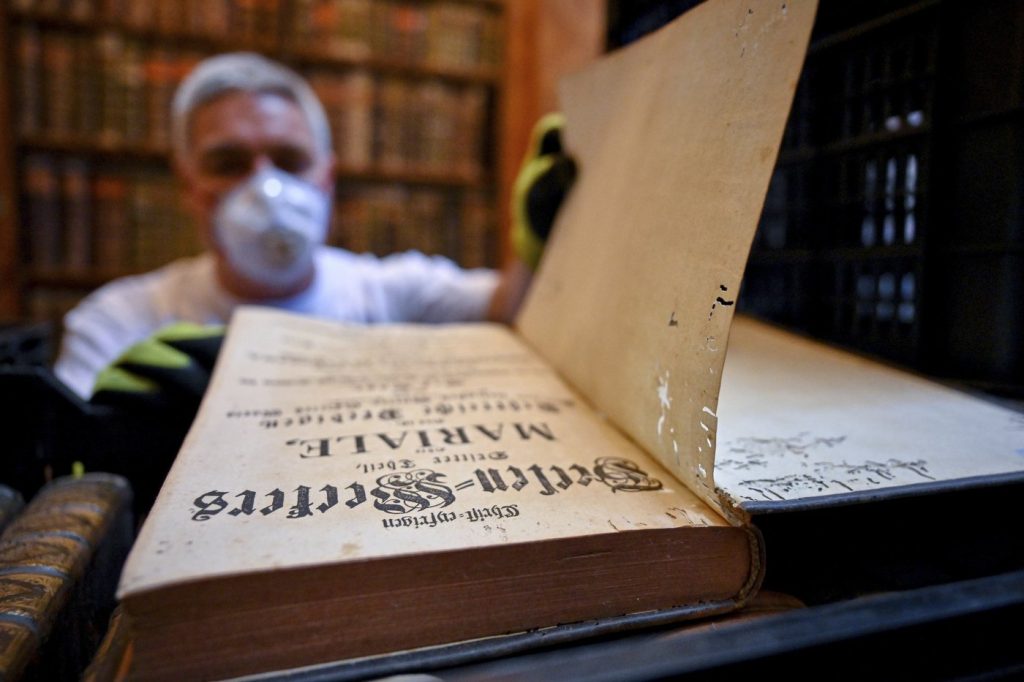PANNONHALMA, Hungary (AP) – A significant effort is underway to safeguard tens of thousands of ancient books at the Pannonhalma Archabbey, a historic medieval monastery in Hungary, from a pervasive beetle infestation that threatens to obliterate centuries of culture and history. The Pannonhalma Archabbey, established in 996, stands as one of Hungary's oldest centers of learning and has been recognized as a UNESCO World Heritage site.
Restoration teams have embarked on the meticulous task of removing approximately 100,000 handbound books from the abbey's library shelves. These books are being carefully placed into crates as part of a disinfection initiative designed to eradicate the drugstore beetle, an insect notorious for burrowing into books due to its attraction to the gelatin and starch-based adhesives used in their binding.
The infestation was first noticed during a routine cleaning when library staff observed unusual dust layers on the shelves and discovered burrow holes in the spines of several books. Upon further examination, it was evident that the beetles had already caused damage to the pages themselves. Zsófia Edit Hajdu, the chief restorer overseeing the response, indicated that the infestation is notably advanced and affects several sections of the library, necessitating treatment of the entire collection simultaneously.
The abbey's library is home to around 400,000 volumes, making it a crucial repository for Hungary's literary history, including the nation's oldest collection of books and significant written records. For over a millennium, the abbey has endured various historical challenges, including wars and foreign invasions, such as the Ottoman attack in the 16th century. Ilona Ásványi, the library's director, expressed her deep appreciation for the library's heritage, noting the awe that comes with being one of the stewards of the earliest book catalogue in Hungary.
The library contains remarkable works, including 19 codices and a complete Bible from the 13th century, alongside numerous manuscripts that predate the invention of the printing press in the mid-15th century. Ásványi stressed the emotional impact of witnessing damaged books, as it signifies the irreversible loss of cultural heritage, regardless of how many copies might exist.
In response to the infestation, the abbey has implemented a rigorous procedure to treat the infected materials. The affected books are being stored in tall, hermetically sealed plastic bags, from which all oxygen is extracted. It is anticipated that a six-week period in a pure nitrogen environment will effectively destroy the beetles. Each book will be meticulously inspected and vacuumed prior to being reshelved, with any damaged materials set aside for future restoration efforts.
The abbey's officials suggest that climate change is a contributing factor to the beetle invasion, as rising temperatures in Hungary could facilitate increased insect development cycles. Hajdu noted that higher temperatures create ideal conditions for pest proliferation, which has shifted the focus of preservation efforts from primarily combating mold to addressing insect infestations. Ásványi reflected on the responsibilities inherent in preserving the abbey's vast collection, as outlined in the Rule of Saint Benedict, emphasizing the intrinsic value of all monastery property.
The dedicated efforts at Pannonhalma Archabbey highlight the challenges faced in preserving historical treasures amidst environmental changes, ultimately underscoring the importance of maintaining cultural heritage for future generations.










